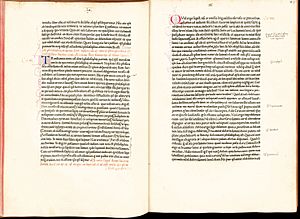Arnold Pannartz and Konrad Sweynheim facts for kids
Arnold Pannartz and Conrad Sweynheym were important printers in the 1400s. They worked with Johannes Gutenberg, who invented the mechanical movable-type printing press. These two printers helped spread Gutenberg's amazing invention to Italy.
Early Lives and Backgrounds
Arnold Pannartz might have been from Prague, a city in what is now the Czech Republic. Conrad Sweynheym was likely from Eltville, a town near Mainz in Germany. Some historians believe Sweynheym worked with Johannes Gutenberg in Germany between 1461 and 1464. It's not known if Pannartz and Sweynheym knew each other in Germany. However, we know for sure that they were the ones who brought Gutenberg's printing press to Italy. Pannartz passed away around 1476, and Sweynheym in 1477.
Their Printing Work in Italy
The Benedictine abbey (a type of monastery) in Subiaco, Italy, became the first place in Italy where books were printed. It's thought that Cardinal Giovanni Turrecremata, who was in charge of the Subiaco abbey, invited the two printers there. They arrived in 1464.
Their very first book printed in Subiaco was a "Donatus," a Latin grammar book, but no copies of it still exist today. The oldest book printed in Italy that we still have is a work by Cicero called De oratore. It was finished before September 30, 1465. After that, they printed De divinis institutionibus by Lactantius in October 1465. They also printed De civitate Dei by Augustine in 1467.
These first four books from Subiaco were very important. They were different from earlier German books because they didn't use the old, dark Blackletter style of writing. People in Italy wanted a clearer, more open style. Pannartz and Sweynheym created a new kind of Roman character font. It wasn't completely Roman, but it was a step towards the clear fonts we see today.
In 1467, the two printers moved from Subiaco to Rome. There, the brothers Pietro and Francesco Massimo gave them a house to use. In the same year, they published a collection of Cicero's letters. This book gave its name to a special measurement unit used in printing called cicero. This unit is similar to the "pica" unit used in other parts of the world. Their main editor was Giovanni Andrea Bussi, who was a bishop at the time.
Pannartz and Sweynheym created two lists of their published works in 1470 and 1472. By 1472, they had printed 28 different books. These included religious books like the Bible, and works by famous classical writers like Cicero, Virgil, and Pliny. They usually printed between 275 and 300 copies of each book. In total, they printed about 12,475 books!
Support from the Church
Like their teacher, Johannes Gutenberg, Pannartz and Sweynheym faced challenges selling all their books. They eventually ran into financial trouble. The Catholic Church was very interested in helping printing spread during this time. In 1472, Pannartz and Sweynheym asked Pope Sixtus IV for help. We know from this request that both men were church officials. Pannartz was from Cologne, and Sweynheym was from Mainz.
Pope Sixtus IV showed great interest in their work. He helped them get financial support. In 1474, Sweynheym was made a canon (a type of priest) at St. Victor in Mainz. It's not known if Pannartz also received similar help. With the Pope's support, they printed 18 more books in 1472 and 1473.
After this, the two printers went their separate ways. Pannartz continued printing on his own, producing 13 more books. Sweynheym started working on metal engraving. He created beautiful maps for a book called the Cosmography by Ptolemy. This was the first time maps like these were made for a printed book. Sadly, Sweynheym passed away before he could finish this important project.
See Also
- Cicero (typography)
- Books in Italy


